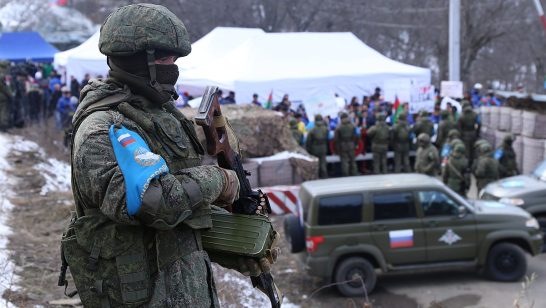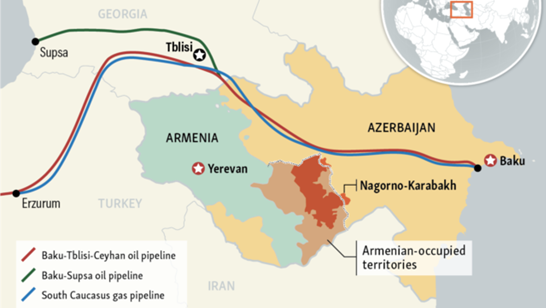
As Russia consolidates what Alexander Cooley has called a new semi-sovereign space embracing secessionist entities in eastern Ukraine, Abkhazia, South Ossetia and Transnistria, there is one such entity that looks on with great interest, but from a certain distance. The Nagorno Karabakh (NK) conflict was the first of the secessionist conflicts accompanying the collapse of the Soviet Union; in terms of scale and numbers of casualties it was second only to Chechnya. Ending in 1994 with an Armenian military victory and the seizure of wide Azerbaijani territories beyond that originally under dispute, the conflict has lingered in the margins of Eurasian politics ever since. Mediating the peace process between Armenia and Azerbaijan is the OSCE’s Minsk Group, which has since the mid-1990s generated no less than five peace plans. Yet to date the political fallout from the likely compromises involved and the top-down nature of the process has prevented progress.
Since a much anticipated but ultimately unsuccessful meeting of the Armenian and Azerbaijani Presidents in Kazan in 2011, escalation and uncertainty have dominated the NK conflict, reflecting both local and regional dynamics. Escalation has been the main short-term dynamic along the 160-mile Line of Contact between Armenian and Azerbaijani forces. The type, intensity and range of ceasefire violations have significantly increased over the last 18 months. Last year, skirmishes in July-August and the shooting down of an Armenian helicopter in November grabbed the headlines. Constant strafing and sniper fire across the de jure Armenia-Azerbaijan border in the Tavush/Tovuz areas, and exchanges in the area of Azerbaijani exclave Nakhchivan, have also extended the geographical range of violations.
Over the medium to long-term, the arms race between Armenia and Azerbaijan has become a much-reported aspect of the conflict, pitting Azerbaijani petro-dollars against Armenia’s deepening alliance (and reliance) on Russia. In September 2013 Armenia was effectively coerced into turning its back on an association agreement with the European Union in favour of accession to Russian President Vladimir Putin’s Eurasian Union integration project. Yet as Russia has strengthened its grip over Abkhazia and South Ossetia with new boundary-dissolving treaties, there are reasons to believe that the de facto entity in NK may be able to keep some distance from Russian integration. Russia has no direct border with Armenia or NK. Neither does it have “passportized” citizens to “protect”, nor peacekeepers on the ground. Russia’s influence over NK is largely indirect, via the deep penetration of Armenia’s economy, infrastructure and security architecture. Armenia’s accession to the Eurasian Union has however raised the possibility of a customs point at the border between Armenia and NK. Unlikely in practice, this still adds to Russian leverage over Armenia.
Over the last year Azerbaijanis have looked at the situation in Ukraine as vindication of their argument with Armenia, claiming that there is no essential difference between Russia’s actions in Crimea and eastern Ukraine in 2014 and Armenia’s actions in NK in 1988-1994. Yet while Armenia’s growing integration with a Russian-controlled space may be a source of short-term validation of Azerbaijani positions, there is little doubt that neither side desires an increased Russian presence in the theatre of conflict. Although the current peace proposal, the Madrid Principles, envisages the deployment of an international peacekeeping operation in NK, conversations on all sides of the conflict reveal consensus on apprehensions regarding the composition, mandate, location and duration of any such force. This negative consensus, serves as a reminder of an easily forgotten feature of the NK conflict: the relative sustainability of a self-regulating ceasefire. Recent escalations detract from this aspect of the Armenian-Azerbaijani truce, which until 2014 had seen no major escalations comparable to those disrupting ceasefires in the Georgian-Abkhaz (in 1998) and Georgian-South Ossetian (in 2004 and 2008) contexts. Reprehensible though the lapses in the Armenian-Azerbaijani ceasefire are, it is still a ceasefire that is managed by Armenians and Azerbaijanis, by themselves, for themselves, on their own.
In this light, the escalation in the range, breadth and severity of Line of Contact clashes, which are driving calls for an increased international presence in the area, is not only worrying, but also puzzling. Azerbaijani frustration with a status quo that over time is normalising the occupation of large swathes of its de jure territory is understandable. There is a clear benefit on the Azerbaijani side of countering perceptions of a “frozen”—and hence in some sense acceptable— conflict. Yet there is a common Armenian-Azerbaijani interest in preserving the exceptionality of NK against the wider canvas of the incorporation of de facto space into Russian-controlled semi-sovereign space. The treaties concluded between Russia and Abkhazia and South Ossetia respectively have further embedded the asymmetry in this process for de facto entities, and leave little doubt as to the fate that would befall NK were it to become part of this space. Whatever outcome might eventually issue from an Armenian-Azerbaijani negotiation would be averted and this conflict would become entangled and submerged in entirely different dynamics on a Eurasian scale.
The “proxification” of Armenia i.e. the depiction of Armenia as a proxy already entirely under Russian influence, and hence the absence of a real interlocutor, is popular in Azerbaijan. Yet local agency and bilateral scope remain much greater in this conflict than others in Eurasia. The dynamic of escalation and the appearance of diminishing control over the Line of Contact area are contracting this scope. In the face of accelerating centripetal pressures that could reshape the NK conflict beyond recognition, Armenia and Azerbaijan need to act to avoid local instability converting into metropolitan opportunity.
The opinions articulated above represent the views of the author(s), and do not necessarily reflect the position of the European Leadership Network or any of its members. The ELN’s aim is to encourage debates that will help develop Europe’s capacity to address the pressing foreign, defence, and security challenges of our time.



